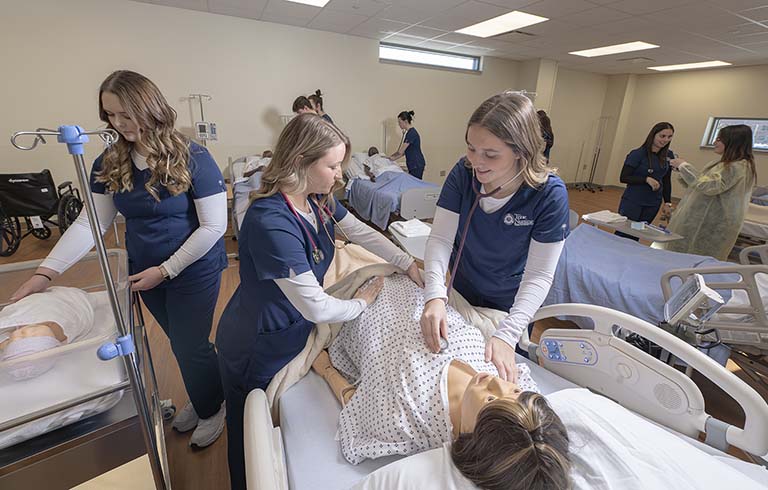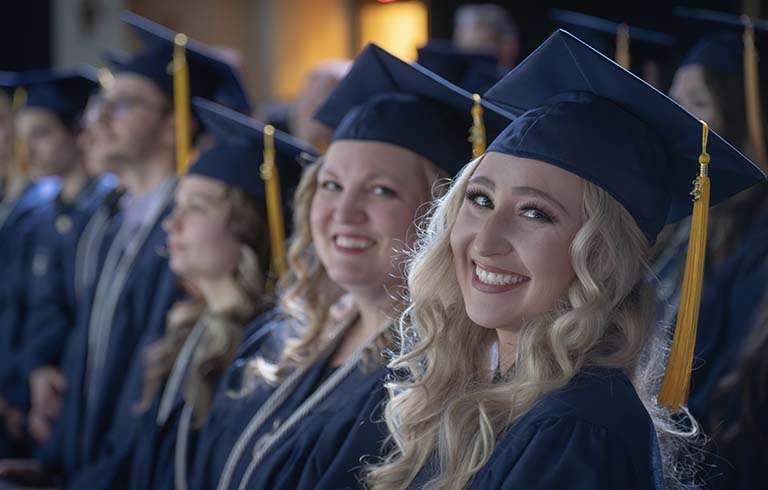They majored in biomedical engineering to help people, and three Trine University
graduates got to see the impact they can make firsthand when they handed off their
senior design project May 13 to a U.S. Marine Corps veteran.
Supported by a BAE Systems program, Kortney Helm of Muncie, Indiana, Madison Howard of Pleasant Lake, Michigan,
and Connor Moon of Toledo, Ohio, designed and built a system to help Chris Billmyer,
a double above-the-knee amputee from Dubuque, Iowa, better enjoy kayaking.
Challenges in the outdoors
Billmyer said he is “a big water sports guy.”
“I love being on the water,” he said. “I was stationed out in California and did a
lot of surfing, skim boarding, snorkeling.”
He served as an Infantry Assault Marine from 2007-2012 and was injured in Afghanistan
on his third deployment. He spent two years in a hospital and now uses a wheelchair
to get around.
He graduated from college about the time COVID-19 hit, and said the pandemic provided
a lot of time to try outdoor recreational activities.
“Being active is one of my top priorities in life,” he said. “When you’re in a chair
or you lose some of your mobility, activity is even more important than when you’re
able to do it all. Your body just breaks down more, so being out is important, mentally
and physically.”
However, outdoor activities can be challenging for those with disabilities. With kayaking
in particular, Billmyer suffered excess shoulder and back strain from lifting the
kayak into and out of the water, in addition to getting wet while launching.
Helping veterans through Tech Power
He connected with a staff member at America’s VetDogs, which partnered this past year with BAE Systems, a global aerospace and defense
technology company, on BAE’s Tech Power: Innovating for Impact program.
“She said there was an opportunity for students to make some stuff for me, so I said,
‘Sure, why not?’ ” Billmyer said.
BAE Systems’ program connects veterans, leading engineering programs at colleges and
universities nationwide, and engineering mentors to create innovative, custom-designed
devices to aid the veterans in their everyday lives.
Working under the mentorship of engineers from BAE Systems’ Fort Wayne facility and
Trine faculty advisors, university senior design teams completed two projects this
past year through the program. In addition to Billmyer’s kayaking system, another
team of Trine biomedical engineers designed a device that detects elevated heart rate
and sounds an alarm to wake veterans experiencing nightmares related to post-traumatic
stress disorder.
Engineering ping-pong
Billmyer said the process began last fall with brainstorming ideas, mostly via email,
with the Trine students.
“It was kind of like a ping-pong match of, ‘Is this good? No. Is this good? No. Is
this good? It was very straightforward,” he said.
“The first semester was getting to understand what Chris’s needs are and seeing what
specifications we needed to hit, whether that was dimensions of his truck or dimensions
of his wheelchair,” said Howard. “Then we went through the whole design phase, coming
up with different concepts.”
Helm said the process provided the students the opportunity to apply skills learned
in class, including “a lot of statistical analysis, CAD modeling (and) finite element
analysis modeling.”
The Trine group eventually decided on a system including a collapsible crane that
fits in the back of Billmyer’s truck to lift the kayak, a collapsible dolly cart with
bag to transport an inflatable kayak, and customized waterproof waders.
During the spring semester, the students built the system and tested it for safety
and fit.
Blood, sweat and tears
Moon, whose father served in the military for 25 years, said he majored in biomedical
engineering with the hope of one day being able to help disabled veterans as a full-time
career.
“To be able to work on a project for my senior design where I get to do eventually
what I would like was really rewarding and made all the blood, sweat and tears worth
it,” he said. “At the end of the day, it wasn’t about our grade, it wasn’t about the
frustrations we were going through, it was about serving a customer and delivering
a product to him at the end of the year that would improve his life greatly.”
“We all became biomedical engineers, in some way, to help people,” Howard agreed.
“This project was something where we could really make an impact and see that impact
in one year.”
It was exciting for Billmyer as well, who planned to try out the new system the next
weekend or the weekend after.
“I’m right on the Mississippi River, so I’ve got the river right there and all the
crooks and creeks and things that flow into it to go up and explore,” he said. “And
then we’ve got Wisconsin; the lakes are right next door.
“The world’s not very accessible, so all the things you can do to make it more accessible
and help you push down that barrier to get out and do things are great.”




